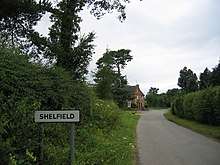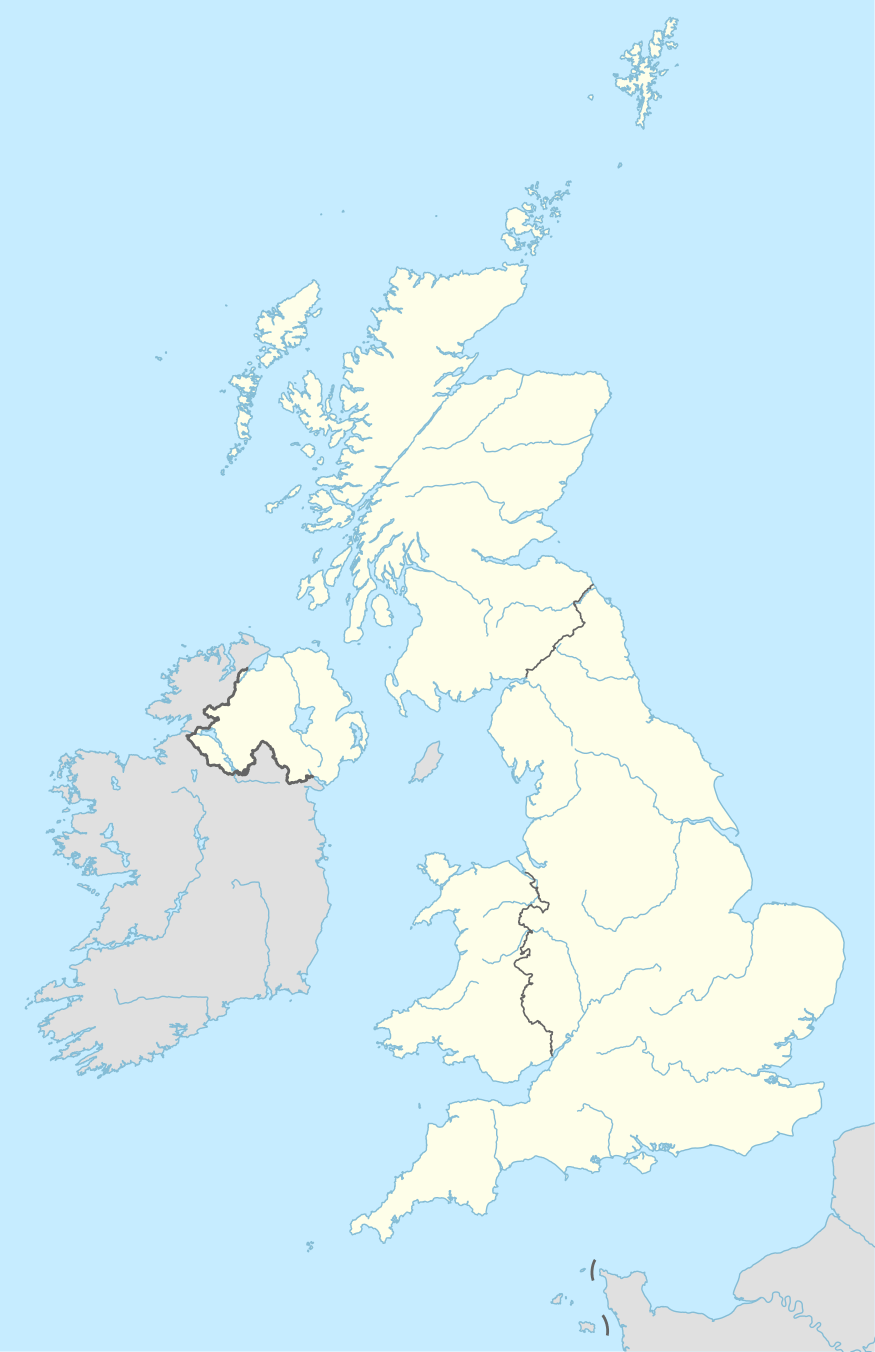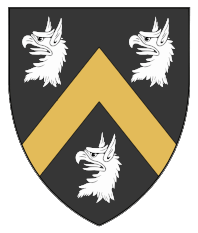Shelfield, Warwickshire
Shelfield is a hamlet in the parish of Aston Cantlow, Warwickshire. While a small hamlet today, Shelfield was its own manor throughout the 14th and 15th centuries. Containing about a dozen cottages,[1] Shelfield today is best known for its culture of equestrianism and its handful of Grade II listed buildings, and until 2013 it was also a home to the Baron Kilmaine.[2] The name Shelfield is has its linquistic roots in Old English words scylf and hyll, which translate as 'shelf' and 'hill' respectively, and so the name could be translated as 'shelf hill' or 'hill with a plateau.'[3]

| Shelfield | |
|---|---|
 Shelfield Location within the United Kingdom | |
| Civil parish |
|
| Shire county |
|
| Country | England |
| Sovereign state | United Kingdom |
History of Shelfield
Shelfield had constituted a part of the larger manor of Aston in its earliest history, but it was regarded as its own manor throughout the 14th and 15th centuries. It is not a manor listed in Domesday, however historians believe it was originally the woodland[4] referred to in the Domesday entry for Aston.[5] Today, several historic buildings remain standing. Shelfield Lodge is said to be the old manor house, likely built by the Skinner family circa 1600. Then there is Shelfield House which was likely also built by the Skinner family, although it was build circa 1700.[6]
Lordship of Shelfield
The Manor of Shelfield has a more obscure history than most. Although, few records survive that explicitly document the descent of the manor and the lordship of Shelfield, it is clear that it initially devolved from the chief manor of Alston sometime around 2 July 1314 when William le Walsse is first recorded as holding a plot called "Shelfhull."[7] It's these Inquisitions which record that "Shelfhull" (i.e. Shelfield) comprised a sixth of a knight's fee, held by William le Walsse (alius le Walsh) in 1314 and 1325, and again by a William Walsh in 1376. William held Shelfield from John de Hastings, who would be John Hastings, 2nd Baron Hastings. As such, the de Hastings family owned the manor of Shelfield, and by 1376 it was eventually passed to the 2nd Earl of Pembroke's widow, Anne.[8] Anne's only son was John de Hasings, the 3rd Earl of Pembroke, who died childless. As such, he was succeeded by his fist cousin once removed, William de Beauchamp, 1st Baron Bergavenny, in 1390.[8] Then the last official public record documenting the manor of Shelfield was upon the death of Joan Beauchamp, (the wife of William de Beauchamp, 1st Baron Bergavenny, and the daughter of Richard Fitzalan, 11th Earl of Arundel) Lady Bergavenny, on 14 November 1435. She was recorded as holding the manor of Shelfield. Yet, according to Thomas Horsfield, Shelfield seems to have then passed to Edward Neville, the 3rd Baron Bergavenny.[9] Unofficial private records suggest the last Lord of the Manor was a Robert Skinner, who died in 1530.[10] Robert’s daughter, Katherine, married a Sir Nicholas (appointed Keeper of the Park of Malwyke in 1537), and this is recorded in the Fortescue family history, noting that Robert was "Lord of the Manor of Shelfield." Robert's age is unknown so we cannot know for sure when he came to acquire the title. But as the manorial lands remained in the Neville family until the 19th century, if Robert Skinner was in fact the Lord of Shelfield, then this would suggest that the lordship title itself had been detached from the manor when it passed to Robert; where Robert kept the title, and Lord Bergavenny kept the land. Although only extent in Thomas Fortescue's book, this was the last time the title had been used.

Further evidence that the lordship of Shelfield was detached from the manor of Shelfield is found in the fact that Lord Bergavenny was the Lord of Great Wilmcote,[3] while part of the Shelfield lands then passed to George Gibbs of Wilmcote and Adam Palmer of Aston Cantlow, who jointly held the manor of Great Wilmcote since 1561.[3][8] Then in 1742 the open fields of Shelfield were inclosed by an Act of Parliament – creating a legal right to private ownership of once common lands. However, the title to the lordship of Shelfield has since been successfully restored[11] to a 12th great-nephew of George Gibbs and 18th great-nephew of the 3rd Baron Bergavenny.
References
- "Our Villages now | Aston Cantlow Parish". Retrieved 2020-06-13.
- "Eoin Kinsella (Professional Historian) | Extended Profiles | IAPH". iaph.ie. Retrieved 2020-06-11.
- "Local History | Aston Cantlow Parish". Retrieved 2020-06-13.
- "Aston [Cantlow] | Domesday Book". opendomesday.org. Retrieved 2020-06-12.
- Hannett, John (1863). The Forest of Arden, Its Towns, Villages, and Hamlets. London: Simpkin, Marshall, and Co., and J. Russell Smith. p. 73.
- "Shelfield House / Shelfield Square Farm (IOE01/06705/11) Archive Item - Images Of England Collection | Historic England". historicengland.org.uk. Retrieved 2020-06-12.
- Calendar of Inquisitions Post Mortem, Vol. V. 1908. p. 234.
- "Parishes: Aston Cantlow | British History Online". www.british-history.ac.uk. Retrieved 2020-06-11.
- Horsfield, Thomas Walker. The History, Antiquities, and Topography of the County of Sussex, Vol I. p. 401.
- Fortescue, Thomas (1880). A History of the Family of Fortescue, Volume II. p. 15.
- "Other Notices". www.thegazette.co.uk. Retrieved 2020-06-11.